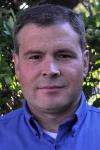Fourth USM Study to Measure Coast Residents Resilience Against Disasters
Tue, 10/16/2018 - 01:19pm | By: Geoff LoCicero
David Cochran and Joohee Lee have a pretty good idea about how prepared Mississippi Gulf Coast residents are for the next Big One, whether it be a natural or a manmade disaster.
The short answer: Less and less prepared every day, as the memories of Hurricane Katrina in 2005 and the Deepwater Horizon oil spill in 2010 diminish – and as the turnover in population produces new residents who never experienced the disasters in the first place.
Cochran and Lee do not work in emergency management but instead are researchers at The University of Southern Mississippi. Later this month and into November, they will begin data collection for a fourth survey since 2010 on the adaptation and resilience of Coast residents.
‘Dependent on Recent Memory'
“Our purpose was to look at how these coupled disasters affected people,” says Cochran, a geography professor. “Some of the original questions were along the lines of: Does prior experience influence the perception of risk? Does prior experience influence the ability to bounce back?
“In the 2015 and '17 surveys, we could see the distancing of these events in the memory of people, so we know adaptation and resilience are dependent on recent memory; and then as that memory fades, so do, perhaps, some of those good behaviors.
“People get sloppy.”
But in fairness, Cochran points out, the oil spill did not universally affect the population in the same way that Katrina did as it indiscriminately cut a swath through the state.
“The oil spill only impacted some parts of the Coast and some segments of society,” he says. “It affected large numbers of people in certain industries, but we documented very few on the Mississippi Gulf Coast. ... With the oil economy, the offshore people live all over, not just on the Coast. We just couldn't measure it; it wasn't on the people's minds as much as Katrina, at least among the people we sampled.”
Where they did measure anxiety over the oil spill, it was attributed to misinformation in the aftermath. “There were a lot of rumors out there, so when people do not get the correct information, it causes fear,” says Lee, an associate professor in social work.
New Surveying Oct. 27, Nov. 3
Canvassing neighborhoods in Hancock, Harrison and Jackson counties, teams of student workers collected 358 surveys in 2010, 379 in 2015 and 328 in 2017. They will again be knocking on doors south of I-10, on Oct. 27 and Nov. 3, using a random sampling method that has identified specific addresses to target.
The researchers have been in a mad dash to collect data before more memories fade – and before their funding runs out. The Mississippi Integrated Health and Disaster Program, a grant-supported initiative through the School of Social Work, is funding the final three surveys; MIHDP is part of the $105 million Gulf Region Health Outcome Program, created as part of the Deepwater financial settlement.
“In 2015, people still remembered Katrina from direct experience,” Cochran says. “But we saw a marked decrease in the number of people who experienced Katrina; it was not like night-and-day, but a notable decrease. Some of these people literally weren't here for the storm. And so it's very interesting to see that part of the recovery process is a replacement of people. People cycle out, people cycle in.”
Post-Traumatic Growth From Adversity
Lee says residents' health and mental health are key indicators in how they adapt to a disaster. “So when a disaster hits a community, the person with psychological resilience and good physical and mental health is more likely to adapt,” she says.
From their findings, Lee has written about the phenomenon of post-traumatic growth, the idea of turning a negative into a positive. Or, as the saying goes, what doesn't kill you makes you stronger.
“It's especially true for those who have strong social support or social capital,” she says. “They experience more growth through this adversity.”
Adds Cochran, “Being a member of something, knowing that you have people who will help you, a community, these are important factors. It's not that social capital causes more post-traumatic growth, but those who have grown from trauma, from disaster, those individuals seem to also have a pretty rich social world. With the experience of the disaster, there is some cause to say the people become more prepared and resilient. Not everybody, obviously, but there is at least a connection there statistically.”
Younger Population Less Prepared
Not surprisingly, age is a positive contributing factor in terms of preparedness.
“We looked at age as a proxy for experience, and certainly people who have lived a long time on the Coast and experienced Katrina are older,” Cochran says. “They're here for life. Many of the younger population hadn't experienced Katrina or had experienced it as children, so they admitted to not being as prepared.
“They didn't know where to go for the evacuation, didn't know about contra-flow (reversing of southbound traffic to expedite evacuations north), didn't know where the shelters were, and didn't have a hurricane kit. The older generation, by contrast, knew this stuff pretty well.
“With fear and with experience comes a certain degree of wisdom and preparedness. There is no significant difference in the variance of response to the question of, Are you at risk? Everyone knows they're at risk; it's just the older ones who had more experience seem to have a little more idea of like, I need to get my act in gear.”
Fear, Risk Perception and Day-to-Day Resiliency
Fear, the researchers say, can be a powerful motivator, but it is not healthy because it generally is tied to depression or other mental health issues. A similar, but more positive attribute is “risk perception,” which is a dispassionate and more logical form of awareness or adaptation.
“Fear is what gives you an ulcer,” Cochran says. “Risk perception can be motivated by fear, but it is also a behavior. If it translates into bolstering resilience, it's good. But you don't want it to make you not act in the face of risk.”
Cochran says, despite the studies' emphasis on disasters, many Coast residents are struggling day-to-day with issues of resilience. The three-county area measures poorly compared to national averages for poverty, median household income and number of uninsured. Those with lower incomes and without health insurance struggle more from mental health problems in the aftermath of a disaster, Lee says.
“Particularly in 2017, we saw people who are really just getting by,” Cochran says. “They're having trouble coping. There was this element, this theme, that there's a lot of struggle on the Coast. You have that as a matter of course in daily life. Then you throw in a hurricane every 15 years or so, it can be a tipping point for some.”
All the more reason, he adds, to build those social bonds.
“A lot of resilience research is about the next hurricane, but what I'm finding from my interaction with the data is that there's more of a general day-to-day resilience based on connectivity and social capital. If you hang out with people who are positive, if you're a member of a church or a spiritual community, or you volunteer to help others, this makes you have a better outlook on life. Or it least it potentially can.
“A better outlook goes hand in hand with resilience. Do you just lay down, or do you get up and keep fighting?”
Trying to Answer ‘Big Questions'
Cochran says a project of this nature requires an interdisciplinary approach with researchers who bring different perspectives and skills.
“Big questions really require multiple disciplines: What is sustainability? What is resilience? How do you live appropriately and sustainably on the Gulf Coast? That's not for a single discipline to answer. We've had social workers, geographers and now a biostatistician from public health. With the broader integrated health research group, we've had medical doctors come in, and we've worked with marine scientists, coastal scientists and oceanographers.
“To me, I think it's the idea of looking at the Gulf Coast as a blended human environment. Why are there people who are just getting by on the Gulf Coast? Why is a whole segment of the population poorly equipped to deal with daily life? Those are pretty big questions.”
--
Learn more about the USM School of Social Work
Highlights from 2017 Survey
|
|
Agree or Strongly Agree
|
|
1. I am at risk from future disasters. |
76.5% |
|
2. I am well prepared to deal with future disasters. |
75.4% |
|
3. I have a personal emergency preparedness kit that I maintain on a regular basis. |
54.5% |
|
4. I know where emergency shelters in my community are located. |
72.6% |
|
5. I understand the disaster evacuation plan for my community. |
67.5% |
|
6. I know what to do after hearing an emergency warning (siren, radio, TV, cell phone). |
91.2% |

